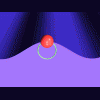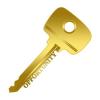Can i get an indicator which catches all the swing turning points ?
Sure, welcome to the world of curve fitted systems. We have an army of snake oil salesman waiting to take you on a tour of "Bottom picking system", "Top picking system", "Top/Bottom picking hybrid system". Seriously there's nothing that a beaten down trader wants other than a magical indicator, which can catch the swing turns with accuracy. Especially when the indicator is nicely displayed with the price chart, catching all the turns, you have a gauranteed customer.
Now here's the problem. By the virtue of the underlying mathematics of most Momentum based indicators, it virtually impossible to have the indicator display the same behaviour under different market contexts. If one defines for simplicity sake that there are three types of markets BULL (rising EMA), BEAR (falling EMA) and SIDEWAYS (flat EMA), you bet the indicator would show different types of behaviour in different contexts. So having a holy grail indicator which would work in all three contexts would require tweaking or forcing or tuning the indicator to catch all the turns in apparently different market contexts. Well by playing with the different parameters in the indicator, it's possible to acheive that, but it's a backasswards way of developing a system. If one develops a system with the means i described above, it would be a nice mechanical system that works like a charm in a particular market context and fails miserably when the market characteristic changes. Now i constantly hear the phrase, "Indicators are useless. They change the locks on the market every few years". That's true of mechanical systems, because they are designed with a backassward approach. If mechanical systems really worked, i would be trading from Tahiti, with all those polynesian beauties around, showing how cool a guy i am, pressing a button on every signal beep and counting millions.
Here's an example of a forced indicator.Now it took me a total of 15-minutes to whip up these two indicators. I could the sell the first indicator as one which catches all the bottoms (major and minor ones) and the second one which catches only the major bottoms. Now how naive could someone be, who beleives that a indicator can know whether a bottom is a major or a minor one. Now do you think this indicator would work when tested over a period of 100 years. You bet not !!. Now if you ask a "Trading Systems" salesman, why it failed over a certain period, he would respond by saying that it was designed for the current market conditions. Now how do i know, when the market conditions change ?
There are even more clever curve fitted systems which looks like a cyclical indicator which catches all the swing turns, which are purely mathematical curve fitting algorithms, which operate on a data series. Let's not even get there. This discussion is about momentum indicators.


What are those magical settings you use on your indicator ?
The answer is, "It's irrelevant". Indicator settings are either fast or slow, depending on the style of the trader. Aggressive traders who try to play all the wrinkes on the chart keep their settings fast. Slow traders who care less about the minor wrinkes keep the settings slow. But there' nothing like a magical setting that catches all the turns. It's the obverver of the indicator who catches turns, while the indicator just reports what's happening in the market. So it's more important to understand how an indicator works rather trying to come up with a magical setting.
If one does not tweak the indicators to catch all the turns, how does one catch the turns or why use the indicator at all?
Here's the meat of "Trading Systems" development. An indicator whether tuned or not, can catch turns. It's only a question as to whether the turn was genuine or not. Even a well tuned indicator, under different market context can give a false signal. That's what a system developer realizes once he starts using the system to make real trades. So forcing the indicator to give what you want and what you would like to see is not the solution. Instead start with an indicator, tune it either fast or slow, depending on your style. Then the system will start churning out signals. Now as we all know, the signals spit out by the system is a random distribution of good and bad signals. Now as long as the system generates more than 40% good signals, it's still possible to make money with good money management. But heck, if a system has such a crappy probability like 40% sucess rate, why bother to develop one ? Instead flip a coin, which has 50% probability of success. So the goal of the system developer is to increase that success rate by filtering bad signals.
How does one filter bad signals ?
This is a very tough question to answer and in all honesty, it's beyond the scope of this thread. But i can throw in some filtering techniques.
1) Let's say you are a 30-min trader and take all the 30-min signals from your system, but would like to filter out the bad ones. This requires a multi-timeframe analysis. One needs to have another chart from a higher timeframe such as 120-min or 240-min. Let's assume that the 120-min flips into a sell.
Filter #1 : Since 120-min is now on a sell, only take the 30-min sell signals and ignore the 30-min buy signals.
Filter #2 : 120-min is not oversold. So continue to take all the continuation 30-min sell signals.
Filter #3 : 120-min is oversold. Do not take the 30-min continuation sell signals anymore, because the higher context is oversold and the trend here could turn on a dime. But if you have a position hold it with trailing stops at prior swing points. Do not take the 30-min buy signals as well, since 120-min is still on a sell.
Now the 120-min turns to a buy. Start taking all the 30-min buys with the above filters.
Not only will this keep one on the right side of the trend and let him/her ride the trend to it's exhaustion, but will also filter out bad signals. If one is a 120-min trader, the same rules apply, but the higher context would be daily in this case.
2) Second level of filtering can be done based on the EMA configuration. For instance one could ingore signals when a EMA is flat or take signals only in the direction of EMA slope i.e shorts only when a particular EMA is sloping down and longs only when the EMA is sloping up. Again it doesn't matter whether one uses 34 EMA or 21 EMA or 55 EMA - whatever works best with your system.
3) Another powerful filtering technique is based on historical backtesting. Go thru different market contexts such as the 80s bull, 70s bear , 1929 bear , 1999-2000 bubble etc and find out where your signals failed. They give some unique insights into how the indicator functions in those scenarios and one could codify those failures into objective rules.
4) Oversold is not a buy signal and overbought is not a sell signal. Divergences are not buy/sell signals. They are just warning signs of an impending turn. They could remain is that zone for a long time in trending markets.
5) Good buy/sell signals come out of oversold/overbought conditions. Let's say one uses a MACD crossover for his/her buy signals. Seriously, can a simple thing like MACD crossover make you money ?? Not unless, it's filtered. Unfiltered signals are the primary cause of frustration with momentum indicators and which is why most people throw in the towel and go for fancy stuff like Bradley, Astro, Gann etc. Let's say i am using a 30-min chart and taking MACD crossover signals. Out of 4 signals i have two good signals and two whipsaws. I could probably have done the same with a coin toss. However try this. Use another indicator which acts as a pure overbought/oversold indicator. I personally like to use the Full Stoch as overbought/oversold indicator. Now take only those MACD buy crossovers when the Full stoch is oversold and MACD sell crossovers when the Full Stoch is overbought. This will not only ensure that you avoid taking those false signals, but will also let you ride the trend longer by ignoring those false whipsaws.
Again, the set of rules for filtering should be minimal so that one can quicky make decisions when the time comes to pull the tirgger.
So in essence, the goal of a system is not make it confirm to price turns but instead using it as a probe to gather information and determine price turns. This requires watching the market and making the decisions, which is a lot of work, as opposed to the lazy approach of the mechanical system making decisions for you. Well, in the end, one gets what one deserves.
Which momentum indicators work the best ?
They are all good. RSI, MACD, CCI, Stochastics, etc as long as one understands how the indicator works and understanding all it's nuances in various market contexts.
I use Full Stochastics as a overbought/oversold oscillator. I use MACD and CCI for determining momentum turns. Of course, with a bunch of EMAs for determining dynamic supports and resistances.
What i have tried to describe is what a general trading system should comprise of, without giving the details of my system, which i have no intentions of giving out. My point is that there are no magical indicators, no holy grail. Don't force your system to see what you want. It's called indicator illusion !


















